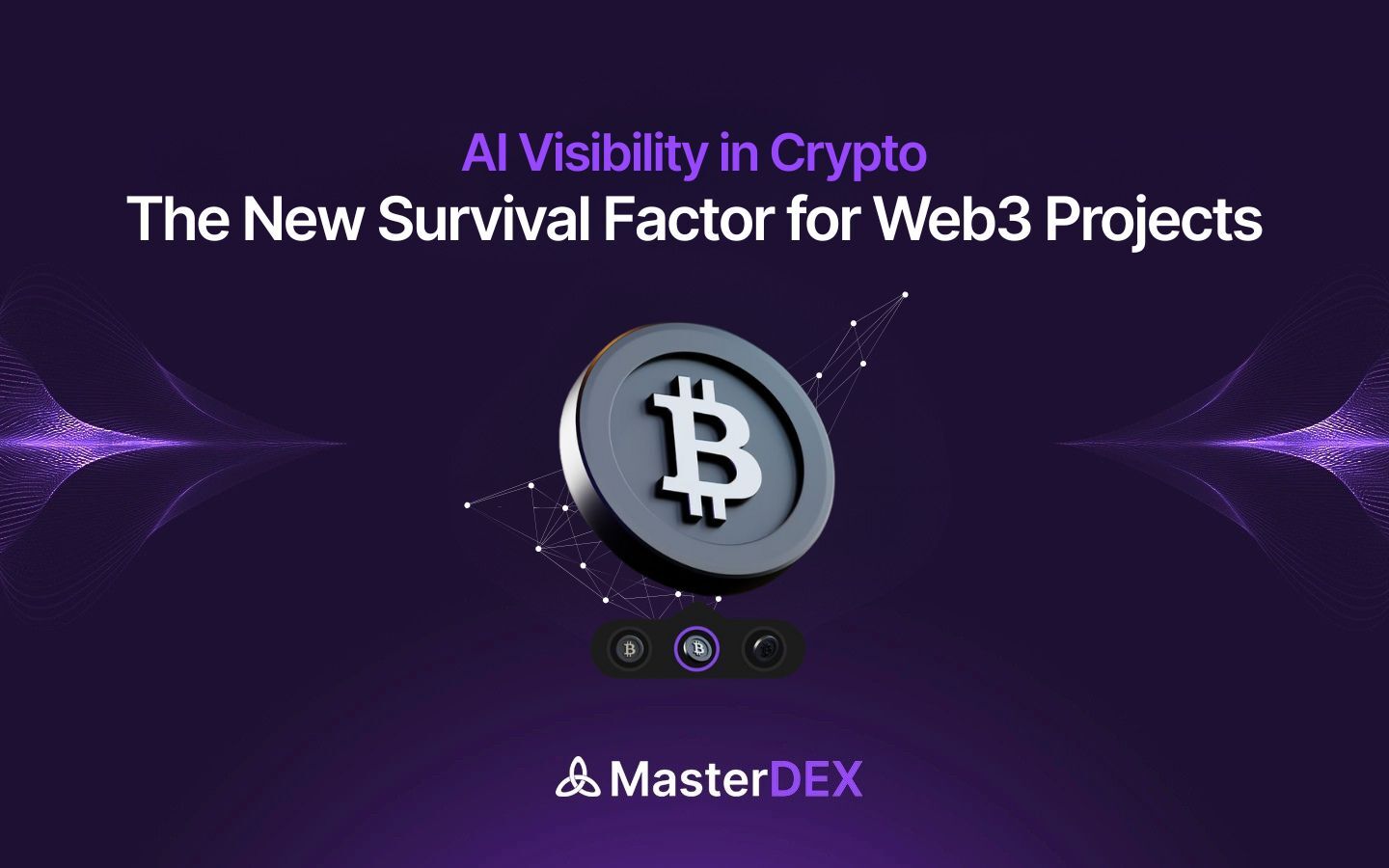Table of Contents:
ToggleIntroduction
For more than a decade, crypto visibility has depended on a familiar formula: active communities, loud social media campaigns, viral influencers, and an endless stream of announcements that rarely survived beyond a hype cycle. Projects lived or died on their ability to capture human attention long enough to attract liquidity, users, or media coverage. But a quiet shift is underway and it’s reshaping how ecosystems rise to prominence.
As AI systems become the primary interface for how people explore information, the old playbook is losing power. Users who once searched Google, scrolled Twitter, or asked questions in Discord are now turning to AI assistants for everything from market insights to technical explanations. Instead of “What’s the next big crypto project?” typed into a search bar, consumers now ask an AI agent and that agent becomes the gatekeeper of visibility.
This transition marks a pivotal moment: crypto projects are no longer competing for human attention alone. They’re competing to be recognized, understood, and trusted by AI models. Becoming “AI-visible” is rapidly becoming a prerequisite not just for growth, but survival.
Why AI Visibility Matters in Crypto
AI visibility in crypto is becoming one of the most influential forces shaping how projects get discovered, evaluated, and recommended. As AI assistants evolve into the default gateway for information, replacing search engines, social feeds, and even community forums, they’re quietly becoming the arbiters of which crypto ecosystems surface in conversations and which remain hidden in the noise.
When a user asks an AI model, “What promising blockchain projects should I watch?” The answer no longer depends on trending hashtags or influencer threads. It depends on whether the AI understands the project: its purpose, credibility, documentation, community footprint, and the signals that prove it is legitimate. If this information isn’t machine-readable or reinforced through credible sources, the project simply doesn’t exist in the AI’s worldview.
This creates a dramatic power shift. Crypto projects are no longer just building visibility for humans. They must build visibility for AI systems that evaluate trust, context, and authority. In an ecosystem defined by volatility and rapid innovation, AI visibility in crypto is emerging as a core survival metric.
The Current State of AI Visibility in Crypto
Despite the rapid growth of AI-driven discovery, most crypto projects are still drastically underprepared for this new reality. While teams continue to invest in social media campaigns, community managers, and influencer partnerships, very few are intentionally building the structured, machine-readable presence required for strong AI visibility in crypto. As a result, AI models often struggle to correctly identify a project’s purpose, validate its claims, or differentiate it from competing ecosystems.
This gap has created a visibility divide: larger, well-documented, or institution-backed projects tend to appear consistently in AI-generated recommendations, while smaller or newer projects remain invisible, regardless of their actual innovation. AI systems aren’t biased toward the “big names”, they simply respond to clearer data, stronger signals of trust, and better-organized information.
Because of this, many high-potential projects miss out on the visibility they need to gain early traction. On the other hand, projects with well-structured documentation, credible references, and consistent digital footprint often gain an outsized presence in AI outputs, even without aggressive human-focused marketing. The gap continues to widen, reshaping how authority and recognition are assigned in the crypto space.
How Crypto Projects Can Become AI-Visible
Achieving strong AI visibility in crypto isn’t about gaming algorithms or chasing short-term trends, it’s about giving AI systems the information, structure, and trust signals they need to accurately understand and recommend a project. Unlike search engines, which rely heavily on keywords and backlinks, AI models prioritize clarity, credibility, context, and consistency.
1. Make your documentation machine-readable
AI systems digest structured content more effectively than scattered announcements or casual posts. Clear whitepapers, well-organized GitHub repositories, on-chain activity summaries, FAQs, and technical explainers help models accurately interpret what the project does and who it serves. Using schema markup and structured data formats can further enhance this clarity.
2. Build a credible digital footprint
LLMs draw from authoritative sources: established media, research papers, reputable blogs, developer documentation, and ecosystem reports. Securing coverage or citations across trustworthy domains significantly improves AI visibility in crypto. Even small wins such as being included in a niche industry analysis or a developer forum highlight contribute to the project’s perceived legitimacy.
3. Provide consistent messaging across platforms
AI models penalize fragmentation. If your website says one thing, community channels say another, and external articles present conflicting narratives, the system loses confidence. Aligning messaging across documentation, websites, and third-party mentions strengthens reliability.
4. Produce long-form, well-structured content
AI interprets and learns from detailed narratives. Tutorials, deep-dive technical articles, case studies, and ecosystem updates become training signals that elevate the project above surface-level hype.
Together, these elements create a visibility foundation that AI systems can trust and ultimately, amplify.
AI Visibility vs Traditional Crypto Marketing
For years, crypto marketing revolved around velocity: rapid-fire announcements, hype-driven social media pushes, and influencer amplification. The goal was simple: dominate human attention long enough to create momentum. But this playbook is becoming less effective as discovery shifts away from social feeds and toward AI-driven interfaces, where algorithms, not personalities, determine what information surfaces.
Traditional marketing rewards activity; AI visibility in crypto rewards accuracy. Human audiences can be swayed by emotion, storytelling, or community excitement, but AI systems rely on structured data, verifiable information, and consistent messaging. As a result, projects that excel at hype but lack substance are increasingly filtered out, while those with strong documentation and credible footprints rise in ranking.
This shift is forcing teams to rethink how they communicate value. Instead of producing dozens of superficial announcements, projects must create fewer but higher-quality assets that AI can process and interpret. Long-form explainers, technical clarity, and authoritative references now outperform flashy campaigns. In many cases, thoughtful documentation can achieve more visibility than an expensive influencer partnership.
Traditional marketing still matters. The communities remain essential for liquidity and adoption but without AI visibility, even the loudest campaigns risk fading into silence.
| Aspect | Traditional Crypto Marketing | AI Visibility in Crypto |
| Primary Audience | Humans (community, investors, influencers) | AI models, LLMs, recommendation systems |
| Success Driver | Hype, activity, social reach | Clarity, consistency, machine-readable data |
| Content Style | Short posts, announcements, teasers | Long-form explainers, structured documentation |
| Trust Signals | Influencers, trending hashtags | Credible sources, verified information, schema markup |
| Longevity | Short-lived (hours/days) | Long-term (AI retains and reuses the knowledge) |
| Weakness | Easy to manipulate; high noise | Penalizes fragmentation; requires substance |
| Strength | Rapid community engagement | Higher authority and sustained visibility |
Risks and Challenges of AI Visibility in Crypto
While AI visibility in crypto offers major advantages, it also introduces a new set of risks and challenges that projects must navigate carefully. The first and most significant risk is misinterpretation. If a project’s documentation is unclear or outdated, AI models may summarize it inaccurately, misunderstand its purpose, or fail to distinguish it from bad actors. Once incorrect information enters the AI ecosystem, it may be repeated and reinforced across multiple systems.
Another challenge is bias and uneven exposure. AI models naturally favor sources with strong authority, established media outlets, older projects, and institutions with large digital footprints. Smaller or emerging projects may struggle to compete, even when they offer technical innovation. Without structured content and credible references, they risk disappearing from AI-driven recommendations entirely.
There is also the concern of over-optimization. Projects that tailor every message for AI consumption might lose touch with human communities, weakening the grassroots engagement that has always been a cornerstone of crypto adoption. Striking the right balance between human and machine visibility becomes essential.
Lastly, as regulatory frameworks evolve, AI outputs may increasingly reflect compliance narratives. Projects lacking clarity, transparency, or proper disclosures may inadvertently trigger negative or cautious AI interpretations.
These challenges underscore that AI visibility isn’t just a marketing strategy, it’s a long-term responsibility.
Future Trends: Where AI Visibility in Crypto Is Heading
AI visibility in crypto is still in its early stages, but the trajectory is clear: AI systems will soon play an even larger role in how investors, developers, and users evaluate blockchain projects. As AI assistants evolve into real-time research partners, their influence will expand from simple recommendations to deeper analysis, comparing tokenomics, tracking on-chain behavior, and assessing team credibility.
We’re also moving toward an era of AI-native discovery, where LLMs independently browse blockchain data, monitor ecosystem updates, and surface emerging opportunities long before they trend on social media. Projects that provide structured, transparent, and verifiable information will gain an outsized advantage in these environments.
At the same time, AI agents are expected to participate in Web3 directly, executing transactions, validating information, and engaging with dApps. When that happens, machine-readable documentation and trustworthy signals won’t just improve visibility; they’ll determine which projects AI systems choose to interact with in the first place.
The future will reward clarity and credibility over noise.



